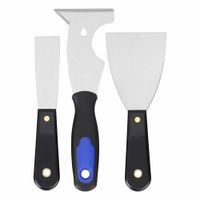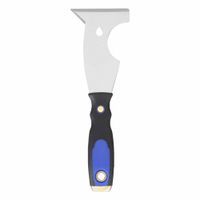Call +(254) 703 030 000 / 751 483 999 / 721 704 777
- Home
- Tools
- Hand Tools
- Scrapers Compound Spreading Hand Tools
.....Read More
Frequently Asked Questions
What are the different types of scrapers and spreaders?
Scrapers and spreaders are essential tools in construction, agriculture, and various industrial applications. Here are the different types:
1. **Scrapers:**
- **Earthmoving Scrapers:** Used in construction for moving large quantities of earth. Types include:
- **Open Bowl Scrapers:** Feature an open bowl for collecting and transporting soil.
- **Elevating Scrapers:** Equipped with a conveyor belt to lift soil into the bowl.
- **Push-Pull Scrapers:** Designed to work in tandem, with one scraper pushing another to increase efficiency.
- **Floor Scrapers:** Used for removing floor coverings like tiles or carpets.
- **Manual Floor Scrapers:** Handheld tools for small areas.
- **Powered Floor Scrapers:** Electric or battery-operated for larger areas.
- **Paint Scrapers:** Used for removing paint or wallpaper.
- **Handheld Paint Scrapers:** Simple tools with a flat blade.
- **Electric Paint Scrapers:** Use heat or vibration to ease paint removal.
2. **Spreaders:**
- **Fertilizer Spreaders:** Used in agriculture to distribute fertilizers evenly.
- **Broadcast Spreaders:** Scatter material over a wide area.
- **Drop Spreaders:** Release material directly below the spreader for precision.
- **Salt Spreaders:** Used for de-icing roads and walkways.
- **Walk-Behind Salt Spreaders:** Manual operation for small areas.
- **Truck-Mounted Salt Spreaders:** Large capacity for extensive coverage.
- **Manure Spreaders:** Distribute manure over fields.
- **Box Spreaders:** Use a chain conveyor to move manure to the rear.
- **V-Tank Spreaders:** Feature a V-shaped tank for efficient unloading.
- **Asphalt Spreaders:** Used in road construction to lay asphalt.
- **Paver Spreaders:** Lay asphalt evenly and compact it simultaneously.
These tools are selected based on the specific requirements of the task, ensuring efficiency and effectiveness in their respective applications.
How do I choose the right scraper or spreader for my project?
To choose the right scraper or spreader for your project, consider the following factors:
1. **Project Type and Scale**: Determine the size and scope of your project. For large-scale projects, heavy-duty scrapers or spreaders are necessary, while smaller projects may only require lighter, more maneuverable equipment.
2. **Material Type**: Identify the material you will be working with. Different scrapers and spreaders are designed for specific materials such as soil, gravel, sand, or asphalt. Ensure compatibility to achieve optimal results.
3. **Surface Conditions**: Assess the terrain and surface conditions. Rough or uneven surfaces may require more robust equipment with enhanced traction and stability features.
4. **Precision and Control**: Consider the level of precision needed. Projects requiring fine control may benefit from advanced models with adjustable settings and precision controls.
5. **Budget**: Evaluate your budget constraints. While high-end models offer advanced features, there are cost-effective options that can meet basic requirements without compromising quality.
6. **Equipment Versatility**: Look for equipment that offers versatility and can handle multiple tasks. This can be cost-effective and reduce the need for multiple machines.
7. **Ease of Use and Maintenance**: Choose equipment that is user-friendly and easy to maintain. This reduces downtime and ensures efficient operation.
8. **Brand Reputation and Support**: Opt for reputable brands known for quality and reliability. Consider the availability of customer support and service centers for maintenance and repairs.
9. **Environmental Impact**: Consider the environmental impact of the equipment. Some models are designed to be more eco-friendly, reducing emissions and fuel consumption.
10. **Safety Features**: Ensure the equipment has adequate safety features to protect operators and bystanders.
By evaluating these factors, you can select the most suitable scraper or spreader for your project needs.
What materials are scrapers and spreaders made from?
Scrapers and spreaders are typically made from a variety of materials, each chosen for its specific properties that suit different applications. Common materials include:
1. **Metal**: Stainless steel and carbon steel are frequently used for their durability, strength, and resistance to corrosion. These metals are ideal for heavy-duty tasks and environments where hygiene is crucial, such as in food processing or medical applications.
2. **Plastic**: Polypropylene, polyethylene, and nylon are popular choices for their lightweight nature, flexibility, and resistance to chemicals. Plastic scrapers and spreaders are often used in situations where metal might cause damage or contamination, such as in delicate surfaces or in the food industry.
3. **Rubber**: Natural rubber and synthetic variants like silicone are used for their flexibility and non-abrasive properties. Rubber is ideal for spreading or scraping on surfaces that require a gentle touch, such as in automotive or glass applications.
4. **Wood**: Traditional scrapers and spreaders are sometimes made from hardwoods like beech or maple. Wood is valued for its natural feel and is often used in culinary applications, such as dough scrapers, where a non-reactive material is preferred.
5. **Composite Materials**: These are combinations of different materials, such as fiberglass or carbon fiber, which offer enhanced strength, lightweight properties, and resistance to wear and tear. Composites are used in specialized applications where performance is critical.
Each material offers distinct advantages and is selected based on the specific requirements of the task, such as the need for flexibility, strength, resistance to chemicals, or non-reactivity.
How do I properly maintain and clean scrapers and spreaders?
To properly maintain and clean scrapers and spreaders, follow these steps:
1. **Immediate Cleaning**: After each use, immediately clean the tools to prevent material from hardening. Use a damp cloth or sponge to wipe off any residue.
2. **Warm Soapy Water**: For thorough cleaning, immerse the tools in warm, soapy water. Use a mild detergent to avoid damaging the material. Scrub gently with a soft brush to remove stubborn debris.
3. **Rinse and Dry**: Rinse the tools under running water to remove soap and residue. Dry them thoroughly with a clean towel to prevent rust or corrosion, especially if they are made of metal.
4. **Inspect for Damage**: Regularly inspect the edges and surfaces for nicks, bends, or other damage. Sharpen or replace blades if necessary to ensure efficient performance.
5. **Lubrication**: For metal tools, apply a light coat of oil to prevent rust. Use a cloth to apply a thin layer of mineral oil or a specialized tool lubricant.
6. **Storage**: Store scrapers and spreaders in a dry, cool place. Use protective covers or sheaths for blades to prevent accidental damage or injury.
7. **Avoid Harsh Chemicals**: Do not use harsh chemicals or abrasive materials for cleaning, as they can damage the tool's surface.
8. **Regular Maintenance**: Schedule regular maintenance checks to ensure all parts are functioning correctly. Tighten any loose screws or fittings.
9. **Proper Use**: Use the tools only for their intended purpose to avoid unnecessary wear and tear.
10. **Training**: Ensure all users are trained in proper handling and maintenance procedures to extend the lifespan of the tools.
By following these steps, you can maintain the efficiency and longevity of your scrapers and spreaders.
Can scrapers and spreaders be used on all surfaces?
Scrapers and spreaders are versatile tools used in various applications, but their suitability depends on the surface type and the specific task at hand.
Scrapers are primarily used for removing materials such as paint, glue, or debris from surfaces. They can be used on hard surfaces like metal, glass, and some types of wood. However, caution is necessary when using scrapers on softer surfaces like drywall or delicate wood, as they can cause scratches or gouges. The blade material and sharpness should be chosen based on the surface to minimize damage.
Spreaders, on the other hand, are used for applying materials like adhesives, sealants, or fillers. They are generally safe for most surfaces, including wood, metal, and drywall, as they are designed to distribute materials evenly without causing damage. The flexibility and material of the spreader (plastic, rubber, or metal) should be selected based on the surface texture and the material being applied.
In summary, while scrapers and spreaders can be used on a wide range of surfaces, their effectiveness and safety depend on the surface material and the tool's design. Proper selection and technique are crucial to avoid damaging the surface.
What safety precautions should I take when using scrapers and spreaders?
When using scrapers and spreaders, prioritize safety by following these precautions:
1. **Personal Protective Equipment (PPE):** Wear appropriate PPE such as gloves to protect your hands from cuts and abrasions, safety goggles to shield your eyes from debris, and a dust mask if working in dusty environments.
2. **Tool Inspection:** Before use, inspect tools for damage. Ensure blades are sharp and free from rust or nicks, and handles are secure and free from cracks.
3. **Proper Handling:** Always hold tools by the handle, keeping fingers away from the blade. Use a firm grip to maintain control and prevent slipping.
4. **Correct Technique:** Apply even pressure and use smooth, controlled motions. Avoid excessive force that could cause the tool to slip or break.
5. **Work Environment:** Ensure the work area is well-lit and free from clutter. Secure the material being worked on to prevent movement.
6. **Blade Safety:** Keep blades covered when not in use. Use blade guards or sheaths to prevent accidental contact.
7. **Storage:** Store tools in a safe, dry place, away from children and pets. Use toolboxes or wall mounts to keep them organized and accessible.
8. **Maintenance:** Regularly clean and sharpen blades to maintain efficiency and safety. Lubricate moving parts to prevent rust and ensure smooth operation.
9. **Awareness:** Be aware of your surroundings and the position of others to avoid accidental injury. Communicate with coworkers about your actions.
10. **Training:** Ensure you are trained in the proper use of scrapers and spreaders. Understand the specific requirements and limitations of each tool.
By adhering to these precautions, you can minimize the risk of injury and ensure a safe working environment when using scrapers and spreaders.
How do I use a painter's multi-tool effectively?
To use a painter's multi-tool effectively, first familiarize yourself with its various components. Typically, a multi-tool includes a scraper, putty knife, paint roller cleaner, nail puller, and bottle opener.
1. **Scraping**: Use the flat edge to remove old paint, wallpaper, or debris from surfaces. Hold the tool at a slight angle and apply even pressure to avoid gouging the surface.
2. **Putty Knife**: The flat, flexible blade is ideal for applying and smoothing putty or spackle. Scoop a small amount of putty onto the blade and spread it over holes or cracks, smoothing it out with the edge.
3. **Paint Roller Cleaner**: The curved edge is designed to scrape excess paint from rollers. Hold the roller over a paint tray and run the curved edge along the roller to remove paint, reducing waste and making cleanup easier.
4. **Nail Puller**: The small, notched edge can be used to remove nails. Slide the notch under the nail head and use leverage to pull it out. For stubborn nails, use a hammer to tap the tool under the nail head.
5. **Bottle Opener**: This feature is straightforward; use it to open bottles when needed.
6. **Caulk Remover**: Some multi-tools have a pointed end for removing old caulk. Insert the point into the caulk line and drag it along to lift and remove the caulk.
7. **Cleaning**: After use, clean the tool with warm, soapy water to remove paint and debris, ensuring it remains in good condition for future tasks.
By understanding and utilizing each feature, you can maximize the efficiency and versatility of a painter's multi-tool in various painting and home improvement projects.



